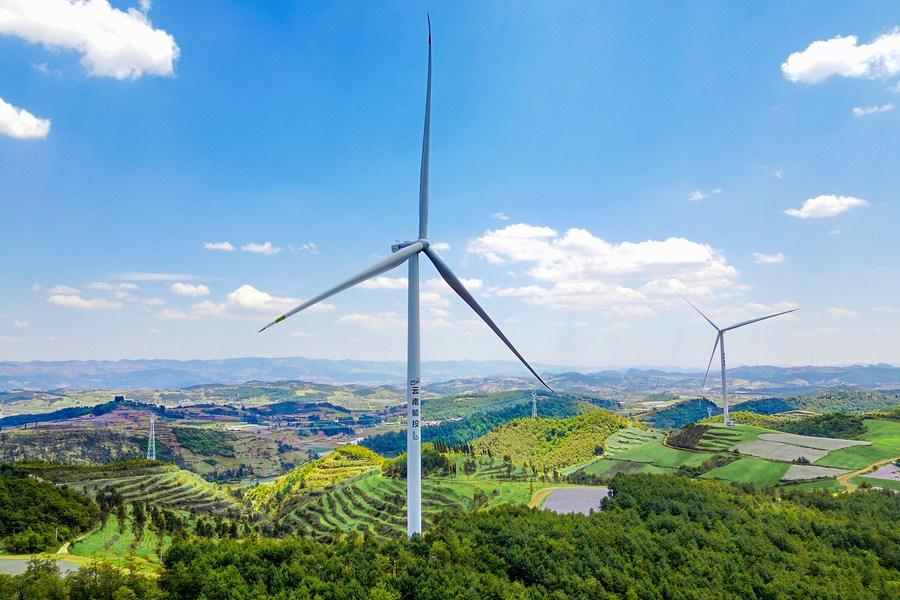Xinhua | May 30, 2023

This aerial photo taken on May 16, 2023 shows wind turbines of Honghe Yongning wind power plant in Honghe Hani and Yi Autonomous Prefecture, southwest China's Yunnan Province.(Yunnan Provincial Energy Investment Group/Handout via Xinhua)
For the past 17 years, Sun Baigang and his team have been dedicating themselves to researching the hydrogen internal combustion engine.
In 2006, Sun, a professor at the School of Mechanical Engineering, Beijing Institute of Technology, started a project on hydrogen internal combustion engines with his research team.
Such engines have now passed through the initial stage of development, and researchers are working to make them more powerful and efficient while maintaining their advantage of zero emissions, Sun said at the ongoing 2023 Zhongguancun Forum, which runs from May 25 to 30 in Beijing.
Technology like that explored by Sun's team has become a strong driving force in accomplishing China's mission of reducing carbon emissions, in particular its "dual carbon" goal of peaking carbon dioxide emissions by 2030 and achieving carbon neutrality by 2060.
In August last year, China revealed a plan for fulfilling this aim through technology, seeking to achieve major breakthroughs in key low-carbon core technologies in key industries and sectors by 2025, together with an 18 percent reduction in carbon dioxide emissions per unit of GDP compared with 2020.
According to the plan, by 2030, China will have conducted further research and made more breakthroughs in a number of cutting-edge and disruptive carbon-neutral technologies, with a view to effectively reducing carbon dioxide emissions per unit of GDP by more than 65 percent from the 2005 level.
"Looking at the international trend, hydrogen energy is the best choice to achieve carbon peak and gradually achieve carbon neutrality," Sun said, adding that their hydrogen internal combustion engine will be available for small-scale application by the end of this year.
Over the years, China has become a pioneer in clean energy development and has continually contributed its strength to the cause of global decarbonization.
Ouyang Minggao, an academician with the Chinese Academy of Sciences and a professor at Tsinghua University, said at the forum that China ranks first globally for the installed capacity growth of renewable energy and sales of new-energy vehicles (NEVs). Ouyang predicted that the number of China's NEVs could reach 100 million to 160 million units by 2030.
On the development of new nuclear technology, the experimental advanced superconducting tokamak (EAST) -- or the Chinese "artificial sun" -- has achieved steady-state high confinement plasma operation for 403 seconds, a key step toward the development of a fusion reactor.
Danny Alexander, vice president of the Asian Infrastructure Investment Bank (AIIB), attended the forum by video link, saying that Asia presents significant potential to play a leading role in responding to climate change thanks to the vast resources, untapped renewable energy resources and the capacity for technological innovation in China and the rest of Asia.
Recycling and the conversion of carbon dioxide also play an important role in achieving the "dual carbon" goal.
At the forum, Ma Yanhe, director of the Tianjin Institute of Industrial Biotechnology under the Chinese Academy of Sciences, presented his research on carbon dioxide conversion and utilization by industrial biotechnology.
Ma's research team designed an artificial starch synthesis pathway consisting of only 11 core reactions, achieving complete synthesis of starch molecules from carbon dioxide in the laboratory.
Ma said this is a promising way to mitigate climate change caused by greenhouse gas emissions, reduce pollution from fertilizers and pesticides, increase the world's food production capacity, and reduce water and food shortages in developing countries.
In the cause of global decarbonization, investment can also play a crucial role in supporting technological innovation.
Chu Gang, chief operating officer of investment bank CICC, said that last year, green investment in China came in at approximately 2.6 trillion yuan (about 368.4 billion U.S. dollars).
According to the latest estimate of CICC Global Institute, by 2060, China's carbon neutrality is expected to bring a cumulative investment demand of 139 trillion yuan, Chu said.
Alexander said that AIIB is looking forward to working with companies and clients from China and around the world to support the transition to a lower carbon economy, and to invest in high-quality projects and new technologies.
"We see particular opportunities for AIIB in promoting the development and commercialization of innovative and cost-effective climate technologies," he said.

